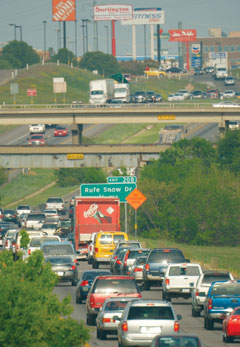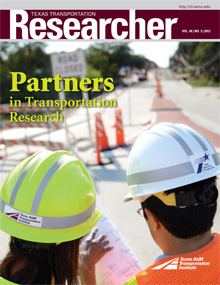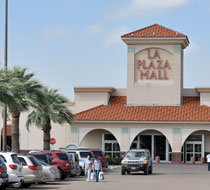For over a half century, planning and analysis have been integral first steps in the transportation project selection process. Three programs at the Texas A&M Transportation Institute (TTI) work together to provide the Texas Department of Transportation (TxDOT) with relevant and accurate data so it can make fully informed decisions on transportation priorities in Texas.
Transportation Planning — Laying the Groundwork

For decades, states have relied on their citizens to answer questions about travel habits. Where are you traveling, what is the purpose of your travel, and how often do you travel? TTI’s Transportation Planning Program conducts research on travel behavior and related travel-data-collection methods to help transportation planners answer these questions.
“In most mid-sized communities and certainly all major urban areas, travel-demand models are used to generate forecasts of future traffic levels as part of the transportation planning process,” says TTI Transportation Planning Program Manager Ed Hard. “The models are important because there’s never enough money to fund all projects, and results from the models can be used to help establish priorities based on where the need is the greatest or will be in the future.”
The program’s research and expertise helped lay the groundwork for TxDOT’s Travel Survey Program, perhaps the most comprehensive survey and data-collection effort to support travel-demand modeling in the United States.
“TTI supports TxDOT’s Travel Survey Program by analyzing information on the different components of travel that make up urban trip making,” explains Hard. “We assist TxDOT with designs and methods for the various types of travel surveys needed to collect information on each component of travel. These include travel related to area households, businesses and workplaces, commercial vehicles, and nonresidents of a given area.”
The Transportation Planning Program has recently started using new technology to collect origin-destination data, historically collected using a roadside travel survey.
“We have teamed with TTI’s Research and Implementation group in Houston to collect data on vehicular movements into, out of and through urban areas using Bluetooth® technology,” says Hard. Accurate data on these trip movements are one of the components of travel needed by TTI’s Travel Forecasting Program for model input. (For more information on this technology, visit the TTI website at http://ttihouston.tamu.edu/bluetooth.)
“Working with TTI on our Travel Survey Program provides a huge benefit to transportation planners,” says TxDOT Travel Survey Program Manager Charlie Hall. “The information can be used to make decisions about future road projects based on individual communities’ transportation needs.”
Travel Forecasting — Identifying Future Growth
Once travel survey data are compiled, they are used to formulate travel-demand models for forecasting future growth and demand for facilities.
“In transportation, there’s one key concept that overrides just about everything in terms of what to build and when to build it, and that is how many people are going to use the facilities,” says TTI Travel Forecasting Program Manager Thomas Williams. “TTI assists TxDOT and MPOs [municipal planning organizations] in developing and maintaining travel models and other programs that forecast traffic for long-range transportation planning.”
Transportation facilities — highways, roads, and bridges — represent significant investments and create the physical backbone of urban areas. That level of investment requires long-term planning, using forecasts 20 to 30 years into the future.
Travel forecasting has also evolved to include other modes of transportation such as transit, bicycles and pedestrians, and focuses more on personal travel behavior and choices. According to Williams, the shift has occurred as researchers are asked to review the efficiency of an existing transportation system, as opposed to the development of an entirely new network of roadways.
The Travel Forecasting Program is conducting several TxDOT research projects and providing technical assistance and technology-transfer support to TxDOT’s Planning and Programming (TPP) Division and MPOs in the state. The program uses survey data generated through TxDOT’s Travel Survey Program and provides input from the forecast models for air quality modeling done by TTI’s Transportation Modeling Program.
Among the beneficiaries of the research conducted by the Transportation Planning and Travel Forecasting Programs is the congestion index used in the annual Urban Mobility Report and the Texas Urban Mobility Plan, both led by TTI Senior Research Engineer Tim Lomax.
Transportation Modeling — Estimating Emissions
TTI’s Transportation Modeling Program also uses the information to estimate emissions in urban areas.
“The Transportation Planning Program collects the data, which are the empirical base of this pyramid. Then Travel Forecasting incorporates all the empirical travel data into its travel behavior models,” says Dennis Perkinson, program manager. “There are a lot of things you can do with this information, including traditional transportation planning. Demonstrating that air quality issues are not introduced is important. And for nonattainment areas, demonstrating air quality conformity is a requirement. That’s an air quality modeling exercise, which is based upon these layers of the pyramid.”
The Transportation Modeling Program develops accurate, reliable methods and procedures for estimating mobile source emissions. The program specializes in forecasting on-road mobile source emissions to demonstrate compliance with planning and air quality regulations, and provides support for TxDOT’s TPP Division through an interagency contract. The long-standing relationships with Texas’ major regulatory agencies — TxDOT and the Texas Commission on Environmental Quality — reflect the program’s commitment to excellence.


